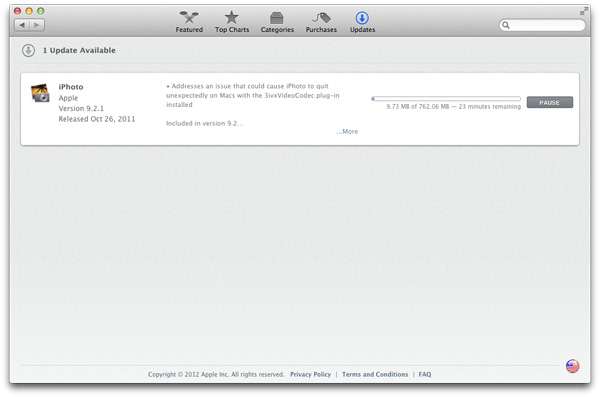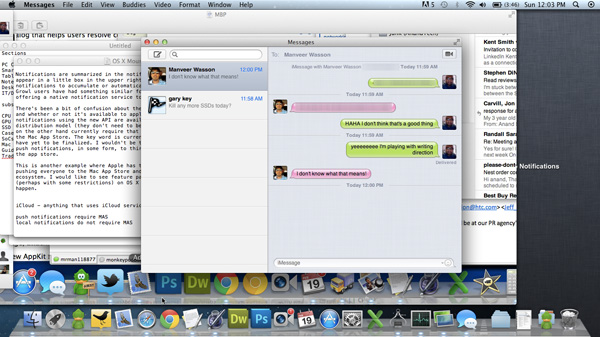Thoughts on the Mac OS X Mountain Lion Developer Preview
by Andrew Cunningham & Anand Lal Shimpi on February 19, 2012 7:40 PM EST- Posted in
- Mountain Lion
- Mac
- macOS
Software Updates & Moving Toward the Mac App Store
To be honest, I rarely use the Mac App Store. I appreciate it because it does let me quickly get Apple applications without fumbling for a restore DVD somewhere, but otherwise I get all of my non-Apple apps directly from the source. The app store makes sense to me on iOS because that's the only option we were presented with from the start, but even there I would appreciate the flexibility of installing apps from any source. On a Mac the opposite is true. Just as was the case on PCs, I've always grabbed and installed software on my Macs from a multitude of sources and I've never really wished there was a centralized, policed repository of Mac applications. That being said, I do understand and accept that I may be a part of a shrinking minority. Apple's most successful products have been those sold effectively as appliances. The MacBook Air took many steps in the same direction by offering no end user upgradeable CPU, memory, storage or battery options. With the MBA you're buying some sort of a Mac appliance hybrid. It's a good device (I'm typing this article on an MBA now), but in many ways it's an inflexible one.
My fear is that as Apple straddles this line between the old and the new, that it will step over too far into the walled garden/appliance territory. That OS X, just like iOS, will become a platform powered only by the app store. That isn't the reality today and I hope that it never will be, but the temptation is surely there. Apple gets a cut of all software sales through the Mac app store, it doesn't elsewhere. App stores are a way of continuing to profit off of a platform after you've sold the initial hardware and operating system. From a customer experience standpoint there's also significant motivation behind supporting only a centralized app store. With complete control of what can run on the platform, Apple could guarantee and maintain the level of experience that it's always been in pursuit of.
Again, today, this isn't a problem but there's definitely movement in that direction. Mountain Lion does away with Lion's Software Update mechanism and instead integrates that into the Mac App Store directly.

There's no change in functionality, just a change in physical location. I will admit that the software update tool always felt like it needed...updating, but I don't know that I would've put it in the MAS application.

Remember all of the new APIs that developers now have access to? A couple of them are only available to applications distributed via the Mac App Store. The big one is iCloud. Any application that interfaces with or uses iCloud is required to be in the MAS. It's the tradeoff you make when you start using Apple's cloud storage as a selling feature of your application. There are ways around this requirement (you could decouple any cloud storage features from your main application and simply offer the former through the app store) but it's a bifurcation of the Mac software feature set for the most part.
The notification story is a little different.
New Notifications API & Interface
Revamping notifications was a major part of the iOS 5 update last year and Apple decided to bring some of that to OS X. Mountain Lion sports a new iPad-like notification center that's accessible by performing a right to left, two finger swipe on a multitouch trackpad. The gesture is unique in that it's the first gesture that must be started at the very edge of the trackpad. A two finger right-left swipe starting in the middle or even an inch from the border of the trackpad is different entirely. To bring up the notifications menu you have to start the gesture at the very edge of the trackpad. It's easier to just start swiping off of the trackpad first, allowing the gesture to then continue onto the trackpad surface. The notification center gesture is very reminiscent of the PlayBook/webOS bezel gestures that have similar requirements for starting outside or at the beginning of the touch area.

Notifications are summarized in the notification center but as they happen they appear in a little box in the upper right of your screen. You can configure notifications to accumulate or automatically disappear after a short period of time. Growl users have had something similar for a while now, but Apple is now officially offering a native notification service to all developers.
There's been a bit of confusion about the new notifications API (NSUserNotification) and whether or not it's available to applications not in the Mac App Store. Local notifications using the new API are available to third party apps regardless of their distribution model (they don't need to be in the Mac App Store). Push notifications on the other hand currently require that the application is distributed only through the Mac App Store. The key word is currently because a lot of Mountain Lion decisions have yet to be finalized. I wouldn't be too surprised if Apple decides to open up push notifications, in some form, to third party applications not distributed through the app store.
This is another example where Apple has to carefully straddle the line between pushing everyone to the Mac App Store and not abandoning the rest of the Mac software ecosystem. I would like to see feature parity regardless of distribution model (perhaps with some restrictions) on OS X going forward, but I'm not sure that will happen.










96 Comments
View All Comments
tipoo - Sunday, February 19, 2012 - link
Safari seems like the last of the major browsers apart from Chrome (which does have it, but buried in the settings) that fails at GPU acceleration, even on mac. Is that any different this time?Guspaz - Monday, February 20, 2012 - link
Chrome buries it in the experimental settings because it's still experimental. In my case, it provides a massive performance improvement to Chrome for even simple use like scrolling pages, but causes Chrome to crash far more often...I really hope they get it done soon, it makes a big difference.
tipoo - Sunday, February 19, 2012 - link
I can't help but feel Apple is headed towards an App store only distribution model for Macs like it is on iOS. Gatekeeper currently lets you choose where apps can come from and lets you still install any programs if you turn it to the most lenient setting, but what about a few years down the line when developers are all onboard the program and Apple feels comfortable enough to stop external sources?solipsism - Sunday, February 19, 2012 - link
If that were the case then why give us that middle option as it will make it harder to remove in the future?sbmassey - Monday, February 20, 2012 - link
Apple still supports Mac Ports, still provides the Terminal application, and still provides the free "Developer Tools" IDE. Given that pretty much all iOS and OSX software development uses some of these tools, I'm pretty sure that Apple is not going to go into full lockdown any time soon.MobiusStrip - Tuesday, February 21, 2012 - link
No, they'll just throw an assload of FUD up on the screen and disable the installation of any app that's not from the App Store by default, even if other options are buried somewhere.chaise2jardin - Wednesday, February 22, 2012 - link
You will have to jailbreak your OSX ! How pathetic....TEAMSWITCHER - Thursday, February 23, 2012 - link
Yes, but in this case Apple has provided the radio button to do it.Bozzified - Sunday, February 19, 2012 - link
"This is another example where Apple has to carefully straddle the line between pushing everyone to the Mac App Store and not abandoning the rest of the Mac software ecosystem. I would like to see feature parity regardless of distribution model (perhaps with some restrictions) on OS X going forward, but I'm not sure that will happen."--
Not only that this won't happen.. but it is an approach that Apple is using to make sure that developers are forced into the Mac App Store. If your non-Mac app store app doesn't have access APIs reserved only for those who distribute through the App Store than you are at a serious disadvantage thus you need to make a version for the app store.
Doing so you basically scar your customers who buy directly, basically forcing you to give Apple 30% and go through the app store.
So if Apple doesn't directly cut off any software that doesn't come from them (or through them) this is the way they will most definitely force developers to give them money.
It is not matter of whether they will do it, but when. By default, deliberately, they have placed a huge warning sign already telling users that they can't run an app that's not from the App Store.. 80% of the users will never go to Preferences to check off unsigned apps and thus forcing developers to again go through the Mac App Store.
Either way, this is a disgusting Apple tactic, that locks everyone in even further into their platform under the disguise of "security".
But I guess, as time passes by, most people "loving" Apple will realize what kind of evil they have been supporting but it will be too late as it already may be.
This is the beginning of the end of the computing as we knew and grew up with it.
MonkeyPaw - Sunday, February 19, 2012 - link
Yeah, even Linux distros are going the wrong way. Rather than making powerful features available through the control panel (like advanced user management), you are only given very simple options through the GUI, and have to resort to the terminal for relatively simple things. I'm referring to Gnome3, and Unity. :(